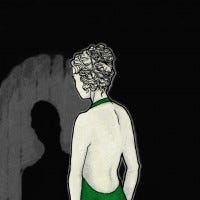Writer and designer Emily Short analyzes Tale of Tales' mysterious The Path, particularly its much-discussed slow pacing, and offers several interpretations of how this slowness serves the experience.

[Writer and designer Emily Short looks at Tale of Tales' mysterious The Path, particularly its much-discussed slow pacing, and how that slowness serves various interpretations of the experience. ] A few weeks ago I wrote of Terry Cavanagh's Don't Look Back that the game works because it is hard. Because it is hard, some people only see the end on YouTube. But the difficulty fit the story; and there are times when a game has to make demands on the player that will, necessarily, cut some people out of the audience. Would The Path work if it weren't so slow? This is the thing you run into, reading reviews of Tale of Tales' Red Riding Hood story. People love it, hate it, want to recommend it but aren't sure how; but descriptions of the piece (which arguably isn't a game) by and large agree that in gameplay terms, it has some problems, and the most serious of them is the agonizing pace. You have to explore the woods with one of six red riding hood avatars, but they are dawdlers, all of them. If you make them run, the camera angle shifts so that you can't see as much of the environment -- and yet even running isn't speedy. There's a lot to find in the game: strange areas of the forest full of memorable and suggestive imagery, things for the girls to look at and think about, fleeting small animals and trees with lacy stylized foliage, and finally, for each of them, a different form of Wolf. And yet for all the content that there is, most of the total play time will be spent trudging between things, rather than inspecting them. To compound the issue, this isn't a game -- or work -- or space -- that you can approach systematically. The woods are confusing, as woods ought to be, and you can make progress at first only by serendipitous discovery. I hate grinding, so I suppose I ought to be all in favor of a piece that cannot be worked through systematically. But I find I hate even more a game situation where I have to wander aimlessly hoping to find something useful to do. That's boring. In fact I spent a lot of time with The Path being really bored. It took me a long, long time to find my first wolf and even longer to get him to interact with me, which somewhat undercut (I thought at the time) the nature of the fairy tale: a threat isn't that threatening if you practically have to harass it into doing you any harm. I kept getting frustrated and wanting to quit. Another fatal sign: the sluggishness of progress made me not want to go look at some of the optional content that I knew existed, once I had worked out the fastest way to get each girl through to her ending. What's It For, Then? So what is The Path gaining through this kind of pacing? I've come up with a few possible answers. One is that the work is effectively hazing the player, removing from the audience anyone who isn't sufficiently devoted. Which might seem like a strange approach, but the thing that compels a person to keep playing The Path (especially if that person isn't playing to review) is a kind of morbid curiosity: a desire to find out what happens that is stronger than every disincentive, even when it's clear that "what happens" is something very unpleasant. Another is that the texture of the game would be wrong without its long dull periods; that it would be missing some sense of anticipation. This I think is closer to being right, though I should admit that I've been skeptical since "The Turn of the Screw" about the aesthetic appeal of suspense via boredom. The third answer is this: being a teenager is itself often intensely frustrating and boring. The constraints on your actions often seem stupid and arbitrary. Privileges come slowly. The world is irritating not least because you are marginalized by it. You are often made to feel like a person-in-waiting. The Path brings that feeling home through both its pacing and the girls' internal monologues -- especially for Ruby, who is at what I recall as the most excruciating stage of adolescence. Curiously, this reminds me of another game about being a teenager, Stephen Bond's Rameses, which also bores the player on a regular basis and with intent. (On the other hand, Rameses is maybe twenty minutes long even so.) I like the last answer the best because it fits my reading of what the game is about. If you've read anything about The Path before, you'll know that it's a very evocative, allusive piece, and that no two players have the same idea about what exactly is going on. The framing material on the developers' website suggests that the six Red Riding Hoods are sisters and that each one literally dies at the end of the story, but some of the endings are so peculiar, and so far from being obviously fatal, that many players look for some more metaphorical explanation of what is happening at each stage. Red Prism My own take is that the six girls are all aspects of the same person, and that they die only in the sense that something happens to change that person radically, to end one personality and inaugurate the new one. I don't share the view expressed by some players that all of the girls are raped; I think there can be sexual imagery and implications in a scene without that signifying an actual act of sexual violence. Overall I think these scenes are not all about rape or about sex or even always about other people, but about the relation between Self and Other that is constantly being revised during the process of growing up. This is the reason that it never especially bothered me to be complicit in the destruction of the girls: at each stage it felt as though I was moving things in the direction that they themselves wanted, and although the results might be traumatic, they were also the means of growth. In fact, it is, I think, possible to see some continuity between the characters, and view the older ones as partly reactions to the younger -- but that would make this article more spoilery than it already is. Ultimately what stands out to me about The Path is the sense of how fragmented one is in adolescence, and how confusing that can be, and how annoying. I think the work risks alienating a significant portion of its players through its pacing, but perhaps the pacing accomplishes something that is at least artistically relevant, by capturing the impatience and frustration of adolescence. The player's need for action mirrors the girls' own impatience to change, to encounter adventures, to grow up, to get free of their current mode of existence. That doesn't mean that I didn't want to scream in irritation during some of the walking sequences. I wish there were a way to do this piece without torturing the player quite so much. But maybe there isn't. It says something for The Path that I still found it overall worth... let's not say playing. Worth working through. Interactivity: it can make a story powerful in new ways, but it's not a guarantee of fun. [Emily Short is an interactive fiction author and part of the team behind Inform 7, a language for IF creation. She also maintains a blog on interactive fiction and related topics. She can be reached at emshort AT mindspring DOT com.]
About the Author(s)
You May Also Like








